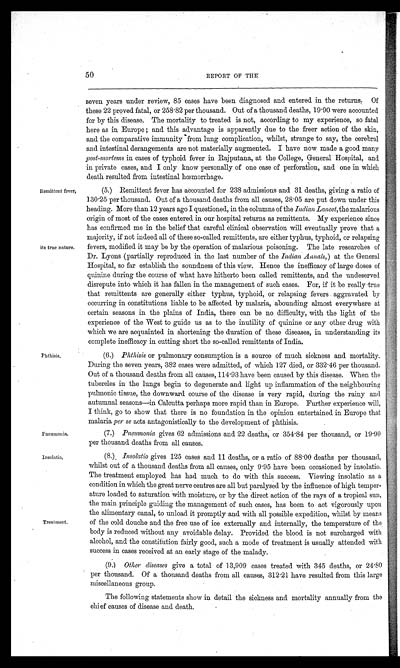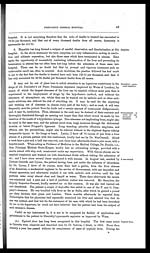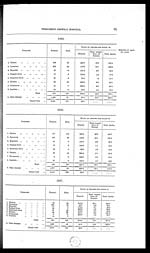Medicine - Institutions > Reports from medical colleges, schools and research institutions > Report on the Calcutta medical institutions > Calcutta medical institutions reports 1871-78 > Report on the Calcutta Medical Institutions for the year 1871
(60) Page 50
Download files
Individual page:
Thumbnail gallery: Grid view | List view

50
REPORT OF THE
seven years under review, 85 cases have been diagnosed and entered in the returns. Of
these 22 proved fatal, or 258.82 per thousand. Out of a thousand deaths, 19.90 were accounted
for by this disease. The mortality to treated is not, according to my experience, so fatal
here as in Europe; and this advantage is apparently due to the freer action of the skin,
and the comparative immunity from lung complication, whilst, strange to say, the cerebral
and intestinal derangements are not materially augmented. I have now made a good many
post-mortems in cases of typhoid fever in Rajputana, at the College, General Hospital, and
in private cases, and I only know personally of one case of perforation, and one in which
death resulted from intestinal hœmorrhage.
Remittent fever,
its true nature.
(5.) Remittent fever has accounted for 238 admissions and 31 deaths, giving a ratio of
130.25 per thousand. Out of a thousand deaths from all causes, 28.05 are put down under this
heading. More than 12 years ago I questioned, in the columns of the Indian Lancet, the malarious
origin of most of the cases entered in our hospital returns as remittents. My experience since
has confirmed me in the belief that careful clinical observation will eventually prove that a
majority, if not indeed all of these so-called remittents, are either typhus, typhoid, or relapsing
fevers, modified it may be by the operation of malarious poisoning. The late researches of
Dr. Lyons (partially reproduced in the last number of the Indian Annals,) at the General
Hospital, so far establish the soundness of this view. Hence the inefficacy of large doses of
quinine during the course of what have hitherto been called remittents, and the undeserved
disrepute into which it has fallen in the management of such cases. For, if it be really true
that remittents are generally either typhus, typhoid, or relapsing fevers aggravated by
occurring in constitutions liable to be affected by malaria, abounding almost everywhere at
certain seasons in the plains of India, there can be no difficulty, with the light of the
experience of the West to guide us as to the inutility of quinine or any other drug with
which we are acquainted in shortening the duration of these diseases, in understanding its
complete inefficacy in cutting short the so-called remittents of India.
Phthisis.
(6.) Phthisis or pulmonary consumption is a source of much sickness and mortality.
During the seven years, 382 cases were admitted, of which 127 died, or 332.46 per thousand.
Out of a thousand deaths from all causes, 114.93 have been caused by this disease. When the
tubercles in the lungs begin to degenerate and light up inflammation of the neighbouring
pulmonic tissue, the downward course of the disease is very rapid, during the rainy and
autumnal seasons—in Calcutta perhaps more rapid than in Europe. Further experience will,
I think, go to show that there is no foundation in the opinion entertained in Europe that
malaria per se acts antagonistically to the development of phthisis.
Pneumonia.
(7.) Pneumonia gives 62 admissions and 22 deaths, or 354.84 per thousand, or 19.90
per thousand deaths from all causes.
Insolatio.
Treatment.
(8.) Insolatio gives 125 cases and 11 deaths, or a ratio of 88.00 deaths per thousand,
whilst out of a thousand deaths from all causes, only 9.95 have been occasioned by insolatio.
The treatment employed has had much to do with this success. Viewing insolatio as a
condition in which the great nerve centres are all but paralysed by the influence of high temper-
ature loaded to saturation with moisture, or by the direct action of the rays of a tropical sun,
the main principle guiding the management of such cases, has been to act vigorously upon
the alimentary canal, to unload it promptly and with all possible expedition, whilst by means
of the cold douche and the free use of ice externally and internally, the temperature of the
body is reduced without any avoidable delay. Provided the blood is not surcharged with
alcohol, and the constitution fairly good, such a mode of treatment is usually attended with
success in cases received at an early stage of the malady.
(9.) Other diseases give a total of 13,909 cases treated with 345 deaths, or 24.80
per thousand. Of a thousand deaths from all causes, 312.21 have resulted from this large
miscellaneous group.
The following statements show in detail the sickness and mortality annually from the
chief causes of disease and death.
Set display mode to: Large image | Zoom image | Transcription
Images and transcriptions on this page, including medium image downloads, may be used under the Creative Commons Attribution 4.0 International Licence unless otherwise stated. ![]()
| Permanent URL | https://digital.nls.uk/74972782 |
|---|
| Description | 13 titles. Describes research work and conditions, treatments, vaccine production, medical education, public health and disease outbreaks. Extensive tables show mortality rates and patient admissions. These - some from asylums, jails, dispensaries, civil and police hospitals – will be useful to epidemiologists. |
|---|




